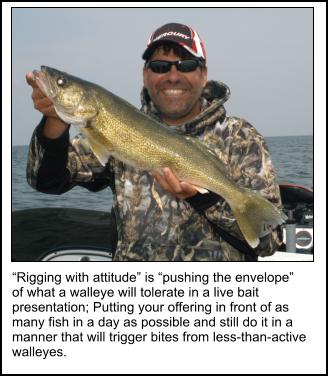Rigging with an Attitude If there is one solid piece of advice we could give you when it comes to catching more walleyes in the peak of summer, its “push the envelope” … push the fish to their limit. You want to be as aggressive as possible to cover water but still be able to get fish to bite! This is “fishing with an attitude”; a mindset that you’re going to find out just exactly what the absolute best presentation is going to be to trigger the most bites on a given day. In many parts of “walleye country”, summertime means “live bait rigging time”, and over the years anglers have been conditioned to slow down and methodically finesse fish during these dog-day walleyes. Modern day walleye fishermen however are looking for the cutting edge of angling techniques and we think when it comes to live bait rigging, there is a new-age philosophy that is moving to the fore-front. No longer are we tied to the notions that “rigging” only means light line, small hooks and an ultra-finesse presentation. This is a good scenario for “pushing the envelope” of what a walleye will tolerate in a live bait presentation; Putting your offering in front of as many fish in a day as possible and still do it in a manner that will trigger bites from less-than-active walleyes. Make no mistake; we are breaking down barriers here. We honestly believe this will change the way you view live bait rigging forever.
The leader is usually made of 6 pound test line, like Berkley Trilene Sensation, or 10 pound test Berkley Professional Grade 100% Fluorocarbon. The hook size will depend on the bait I’m fishing with. For crawlers and leeches it will be a size 4 Mustad Ultra Point Double Wide Bait Hook model 10548R (red). For larger minnows I’ll go with the same hook in a size 1 or 1/0. This is an ideal hook to use for live bait because it is a fine wire hook making it very light which helps give the bait a very natural presentation. Also, as the hook’s name implies, it has a very wide gap, giving you the best chance of getting a good hook-up when the fish takes the bait. We realize this is a far cry from the ultra-finesse spinning outfit and light line most guys would use for live bait fishing. But then we’re not out to coax a few biters. We’re out to catch as many quality walleyes as possible. That’s not to say that you’d want to hit the water at mach speed with this presentation, at least not to start off with. As always, your plan should be to first of all locate what you believe to be a fishable school of walleyes utilizing your electronics. Summer time walleyes, ones that are typically good targets for live bait rigging, are usually set up on structure and in water deeper than fifteen feet. That makes them good candidates for spotting with electronics. Once you feel you’re on a good bunch of fish, will work bottom bouncer live bait rig slowly (typical speed with the bowmount trolling motor will be about .4 mph) through the area to try to trigger a bite. This will tell you a couple of things. It will tell you for sure whether or not you’re fishing walleyes, and if in fact they are in fact walleyes, then you have a good idea of the type of structure and depth to key in on in other areas of the lake. Now is when the “plan” kicks into gear. For ever we’ve heard from accomplished “riggers” that you move slowly along structure until you contact fish and then you “hover” on the school to pick off the biters. That’s not the way this plan works … not at all. Once walleyes are contacted, you want to start pushing the envelope. Start increasing the speed of the presentation. Not by leaps and bounds, but in small increments. Where you first caught a fish going .4 mph, now kick it up to .5 mph, then .6 mph, and then maybe even .7, .8 mph or faster! The object is to test the walleyes and see just how fast you can present that live bait rig and still get them to bite it. The advantage here is that by dialing in on that “presentation speed threshold” you can cover more water and put your bait in front of more fish over the course of a day than any other rigger on the water. A modification to this tactic that has gained great popularity over the past couple of seasons is Slow Death Rigging. The set-up is virtually the same; a leader of 10 pound test Berkley Professional Grade 100% Fluorocarbon, but in this rigging we use a very specialized hook. The Mustad Slow Death Hook model 33862 (available in Red, Bronze or Gold and in 2 sizes, #2 and #4) is an Aberdeen style hook with a unique bend to it that when rigged with a half crawler threaded over the hook, imparts a seductive and deadly spinning action to the bait that fish often find irresistible. Of course, choosing the right bait is always a key to rigging success. It never ceases to amaze us how finicky walleyes are very often more apt to chomp a large bait like a Creek Chub or Sucker rather than nibble a smaller offering like a leech. This is especially true when fishing large western reservoirs, but we’ve seen it in many natural lakes as well. It seems anglers are conditioned to under estimate the appetite of walleyes in a neutral or even a negative mood. There are lots of times though that crawlers and/or leeches will be the best bait choice. But the biggest mistake we see made in the summer is to use inferior bait; bait that’s not lively or otherwise sub-standard. If you’re going to be serious about your walleye live bait fishing, you need to get serious about your bait. Learn how to pick out the best bait available and take good care of it out on the water. Frabill for instance makes all kinds of great bait-care products and these are well worth the investment if you want to be a successful live bait walleye fisherman.
Will this approach work for every live bait rigging situation? No. There
will always be a time and place for the ultra-slow and finesse type of
rigging, particularly when you are faced with fishing very heavily
pressured lakes, gin clear water, and severe cold-front scenarios. But
those circumstances are really more the exception than the rule. Be
skeptical if you want. Stick with the typical slip sinker, light line
rigging methods if it suits you. We are sure you’ll still catch fish.
Just don’t get annoyed at the anglers out there “rigging with attitude”
as they cruise past you on their way to their Next Bite. Editor's Note: If you have questions or comments on this or other articles of ours you may have read, contact us through our website at www.thenextbite.com . |


 When
we approach a summer time situation where the walleye bite is leaning
toward a live bait presentation, the first piece of gear we reach for is
the bottom bouncer set-up. A six and a half to seven foot, medium action
baitcasting outfit spooled with 10 or 12 pound Berkley Trilene
Sensation, or if fishing deeper water (say deeper than 30 feet) we’ll
spool up the bottom bouncer reel with 10 pound test Berkley FireLine.
The small diameter and no-stretch of FireLine gives you much more “feel”
when fishing deeper water. On to that we’ll have tied a bottom bouncer
(depending on the depth of water being targeting this may be anywhere
from one ounce to three ounces) rigged with a three to four foot leader
of and plain bait hook.
When
we approach a summer time situation where the walleye bite is leaning
toward a live bait presentation, the first piece of gear we reach for is
the bottom bouncer set-up. A six and a half to seven foot, medium action
baitcasting outfit spooled with 10 or 12 pound Berkley Trilene
Sensation, or if fishing deeper water (say deeper than 30 feet) we’ll
spool up the bottom bouncer reel with 10 pound test Berkley FireLine.
The small diameter and no-stretch of FireLine gives you much more “feel”
when fishing deeper water. On to that we’ll have tied a bottom bouncer
(depending on the depth of water being targeting this may be anywhere
from one ounce to three ounces) rigged with a three to four foot leader
of and plain bait hook.